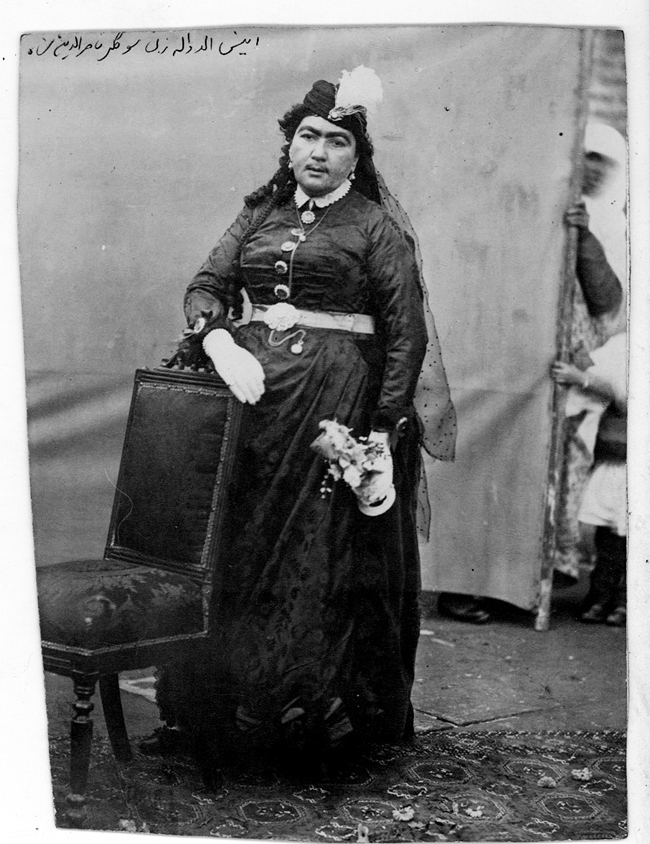|
Amina Aqdas
Amina Aqdas (died 1893) was a royal consort of shah Naser al-Din Shah Qajar of Persia (r. 1848–1896).G. Nashat,Amīna Aqdas" Encyclopædia Iranica, I/9, pp. 954-955, accessed on 30 December 2012. She was the daughter of an impoverished shepherd in a from a village near Garrūs in Kurdistan, and was employed as a free maidservant to the shah's wife Anīs-al-dawla in the Qajar harem in 1859. She eventually became a favorite of the shah, second only to Anīs-al-dawla. Contemporaries attributed her influence to an ability to manipulate of the shah's weak spots: she catered to his whims, encouraged his obsessions, and appealed to his parsimony. Her power was also enhanced by the shah's intense attachment to her nephew, Gholam-Ali, Malijak-e Thani, also known as Aziz Al-Soltan. She supported the career of Mirza Ali Asghar Khan Amin al-Soltan Mirza Ali Asghar Khan ( fa, میرزا علیاصغر خان; 6 January 1858 – 31 August 1907), also known by his honorific titles of ... [...More Info...] [...Related Items...] OR: [Wikipedia] [Google] [Baidu] |
Naser Al-Din Shah Qajar
Naser al-Din Shah Qajar ( fa, ناصرالدینشاه قاجار; 16 July 1831 – 1 May 1896) was the fourth Shah of Qajar Iran from 5 September 1848 to 1 May 1896 when he was assassinated. He was the son of Mohammad Shah Qajar and Malek Jahan Khanom and the third longest reigning monarch in Iranian history after Shapur II of the Sassanid dynasty and Tahmasp I of the Safavid dynasty. Nasser al-Din Shah had sovereign power for close to 51 years. He was the first modern Persian monarch who formally visited Europe and wrote of his travels in his memoirs. A modernist, he allowed the establishment of newspapers in the country and made use of modern forms of technology such as telegraphs, photography and also planned concessions for railways and irrigation works. Despite his modernizing reforms on education, his tax reforms were abused by people in power, and the government was viewed as corrupt and unable to protect commoners from abuse by the upper class which led to increasi ... [...More Info...] [...Related Items...] OR: [Wikipedia] [Google] [Baidu] |
Anīs-al-dawla
file:ملیجک_و_انیسالدوله.jpg, link=https://fa.wikipedia.org/wiki/%D9%BE%D8%B1%D9%88%D9%86%D8%AF%D9%87:%D9%85%D9%84%DB%8C%D8%AC%DA%A9_%D9%88_%D8%A7%D9%86%DB%8C%D8%B3%E2%80%8C%D8%A7%D9%84%D8%AF%D9%88%D9%84%D9%87.jpg, 232x232px, Anis al-Dawla and Aziz al-Soltan Anis al-Dawla (died 1896) was a royal consort of shah Naser al-Din Shah Qajar of Persia (r. 1848–1896).G. Nashat, “ANĪS-AL-DAWLA,” Encyclopædia Iranica, II/1, pp. 74-76, available online at http://www.iranicaonline.org/articles/anis-al-dawla-d (accessed on 30 December 2012). Life She was the daughter of an impoverished shepherd in a from a village in Lavāsān, northeast of Tehran, and was employed as a free maidservant to Jeyran (wife of Naser al-Din Shah) in the Qajar harem in 1859. She became the favorite of the shah after Jeyrān's death in 1860. She was the only wife to take meals with Nāṣer-al-dīn and to join him regularly at bedtime after he received visits from other wives; she was also t ... [...More Info...] [...Related Items...] OR: [Wikipedia] [Google] [Baidu] |
Qajar Harem
The harem of the monarchs of the Qajar dynasty (1785-1925) consisted of several thousand people. The harem had a precise internal administration, based on the women's rank. Hierarchy and organisation Mother of the Shah As was customary in Muslim harems, the highest rank of the harem hierarchy was that of the monarchs' mother, who in Qajar Iran had the title ''Mahd-e ʿOlyā'' (Sublime Cradle). She had many duties and prerogatives, such as safeguarding the harem valuables, particularly the jewels, which she administered with the help of female secretaries. Consorts In contrast to what was common in the Ottoman Empire, where the sultans normally only had slave consorts, the Qajar shah's also had a custom of diplomatic marriages with free Muslim women, daughters of Qajar dignitaries and princes. Another phenomena of the Qajar harem was that the Shah entered two different kinds of marriages with his harem women: '' ṣīḡa'' (temporary wife), which was often done with concubines, a ... [...More Info...] [...Related Items...] OR: [Wikipedia] [Google] [Baidu] |


